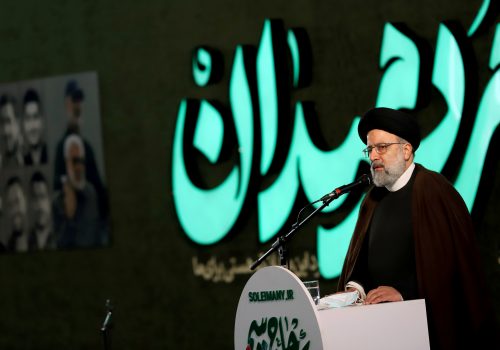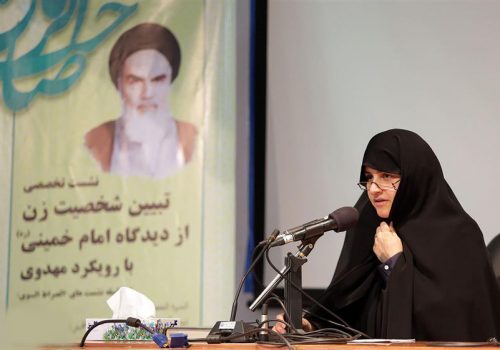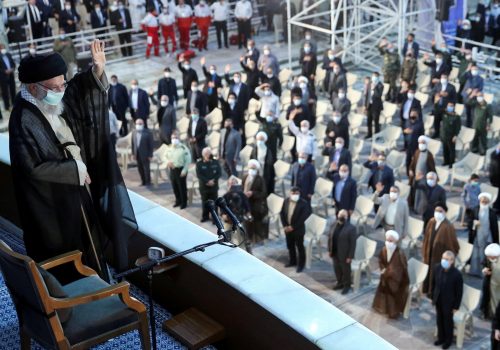Rumors of Mojtaba Khamenei being crowned with the Supreme Leader’s turban have been circulating for years. Now it may happen.
In June 2021, the Guardian Council, a body tasked with vetting and qualifying candidates for elected office, did its best to guarantee that hardliner Ebrahim Raisi was elected president by disqualifying all those who presented any semblance of competition. His presidential win was considered a potential step toward becoming Iran’s real leader whenever incumbent Supreme Leader, Ayatollah Ali Khamenei, passes away.
Other potential successors have pre-deceased Khamenei: former president Ali Akbar Hashemi Rafsanjani in 2017 and former Judiciary chief Mahmoud Shahroudi a year later. Another contender, Ayatollah Sadeq Larijani, has been discredited by allegations of corruption and backlash to his criticism of the security forces for eliminating Raisi competitors, including Larijani’s brother, Ali, a former speaker of parliament. In his first press conference as president in June 2021, some reporters even referred to Raisi as an “ayatollah,” although he spent only five years as a seminary student.
The way has seemingly been cleared for Raisi but the president’s poor performance in his first year in office, particularly regarding the economy, has severely undercut his standing with Iranians, who now regularly chant “death to Raisi” at protest demonstrations. The Iranian media has ridiculed him for failing to clearly state Iran’s inflation rate, which is over 50 percent. At a recent press conference, Raisi said, “last September, inflation rate was 60 percent, it fell to 35 percent in March and April this year and to 4.4 percent in June and to 2 percent in July. Now it is 40.5 percent.”
Other statements by Raisi have also opened him up to attack. For example, his comment on July 29 that “people have formally told us that sanctions can be neutralized by resistance” made him the butt of many jokes. The comment even led to an Internet-based petition signed by thousands of people “formally asking him to immediately end all sanctions by starting a positive and peaceful collaboration with all the countries around the world.”
As Raisi has stumbled, the prospects of the only other likely candidate for Supreme Leader have advanced. Attention is now focused on Khamenei’s second son Mojtaba, who seemed from the outset to be orchestrating Raisi’s presidency—in effect, providing Raisi the rope with which to fashion his own political noose.
Mojtaba Khamenei has a number of tools to promote his candidacy, including strong links with the security and military sector, particularly the Islamic Revolutionary Guard Corps (IRGC). Recently, there have been reports that he is also seeking to obtain the necessary clerical credentials.
Mojtaba’s open interference in the Iranian political domain dates to the suppression of the 2009 post-election protests known as the Green Movement, which arose in response to the fraud-tainted re-election of then-hardline President Mahmoud Ahmadinejad. Since then, Mojtaba has been consolidating his links with the security apparatus. Despite the recent firing of the head of the intelligence arm of the IRGC, reportedly a Mojtaba ally, the Supreme Leader’s son does not seem to have lost his footing with the security and intelligence services.
Mojtaba’s name has come up before as a possible successor to his father, but, in the past few weeks, there have been several comments that seem to suggest that his chances have risen.
On August 9, former Prime Minister Mir Hossein Mousavi, the suppressed 2009 presidential candidate who has been under house arrest for twelve years, wrote an introduction for the Arabic language edition of a collection of his statements. Mousavi harshly criticized Iran’s regional intervention, especially in Syria, mentioning IRGC General Hossein Hamedani, who was killed “dishonorably in support of the child-killer regime of Damascus.” Mousavi also warned that there was a danger that the leadership in Iran was becoming hereditary in the same way as in Syria, where Bashar al-Assad succeeded his father, Hafez.
“The rumors on the conspiracy of a son succeeding his father have been circulating for thirteen years,” Mousavi wrote. “If it is not correct, why doesn’t anyone deny it?”
The comments led to a wave of Iranian press attacks against Mousavi that focused on the IRGC general, but pointedly ignored the reference to Mojtaba replacing his father.
A few weeks later, an Instagram account affiliated with former reformist President Mohammad Khatami posted an item from an obscure news agency that covers Shia seminaries in Iran, reporting that “Ayatollah” Mojtaba Khamenei had started registration of students for his classes at the highest levels of a seminary in the religious center of Qom. While the news of him teaching advanced classes in Qom was not new, it was the first time that the title “ayatollah” was used to describe him in the Iranian press. This upgrade was immediately picked up by many news agencies both inside Iran and abroad.
While Khamenei was also elevated to the status of “ayatollah” when he became Supreme Leader, that succession was engineered by fellow cleric and politician Rafsanjani. Thirty years later, Shia clerics are no longer the sole deciders in Iran, having been eclipsed by the IRGC and other security services. They will not risk losing their power to an untested choice of the Assembly of Experts—the elected body of elderly clerics nominally charged with choosing the next leader of Iran. Only an insider will be allowed to take the job and Mojtaba is an insider par excellence.
The next Supreme Leader must also be young enough to guarantee decades of rule so that the military and security establishment can continue to enjoy economic and other benefits. At fifty-three, Mojtaba is at an ideal age. However awkward it may be for a “revolutionary” regime to embrace hereditary succession, public opinion counts for little in today’s Iran. We should expect more moves by Mojtaba to facilitate his crowning with his father’s turban when the time comes.
The author, who is well-versed in the Iranian political scene, was granted anonymity to share candid observations.
Further reading
Tue, Jun 1, 2021
A Raisi presidential win may be his undoing as future Supreme Leader
IranSource By
Conventional wisdom is that the election will facilitate Ebrahim Raisi’s ascent to the real decision-making post in Iran—that of Supreme Leader. But nothing is ever certain in Iran’s contentious politics.
Thu, Jun 24, 2021
A look at Iran’s new First Lady
IranSource By
It’s important to take a close look at President-elect Ebrahim Raisi's wife, Jamileh Alamolhoda, and, more importantly, how the couple will impact women’s rights in Iran.
Fri, Jul 8, 2022
Iran’s Supreme Leader threatened protesters. But Iranians aren’t listening.
IranSource By
Ayatollah Ali Khamenei explicitly threatened a harsh crackdown on dissidents and proposed limits on the Internet and cyberspace, harkening back to the country’s bloody suppression of dissent during the 1980s.
Image: 31 May 2019, Iran, Tehran: Mojtaba Khamenei (C), son of Iranian Supreme Leader Ayatollah Ali Khamenei, is pictured during a protest marking the annual al-Quds Day (Jerusalem Day) on the last Friday of the Muslim holy month of Ramadan. Photo: Saeid Zareian/dpa



